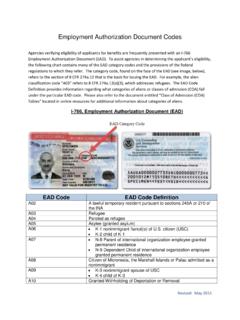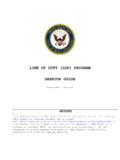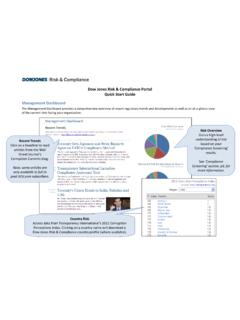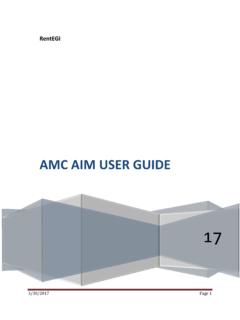Transcription of Guide to Understanding SAVE Verification …
1 Systematic Alien Verification for Entitlements Department of Homeland Security Citizenship and Immigration Services Verification Division Washington, DC 20024 Guide to Understanding save Verification Responses BACKGROUND This Guide provides general guidance for interpreting save responses. The Systematic Alien Verification for Entitlements ( save ) Program is a service that helps federal, state and local benefit-issuing agencies, institutions, and licensing agencies determine the immigration status of benefit applicants so only those entitled to benefits receive them. save does not determine applicants eligibility for specific benefits; the benefit-issuing agencies make those determinations.
2 The save Program offers two methods for accessing information to verify applicants status: electronic and paper-based. Regardless of the access method, save uses online systems to check benefit applicants immigration status or citizenship information against records contained in relevant immigration databases. To use either method, the agency must execute a Memorandum of Agreement with the save Program. Verification PROCESS The majority of Verification requests are resolved upon initial Verification . However, in some instances, immigration status or naturalized or derived citizenship cannot be verified through initial Verification .
3 Accordingly, the save Program will prompt the customer agency to provide additional information or copies of the applicant s immigration/citizenship document in order to verify the applicant s immigration status or citizenship. This does not necessarily mean that the applicant is not authorized to be in the United States or is ineligible to receive the benefit. It simply means that additional research is required in order to determine the applicant s immigration status. Electronic Verification save electronically verifies immigration status or naturalized or derived citizenship using a three-step process: Initial Verification (first step) - electronically compares information the agency enters against immigration databases and returns a response within seconds.
4 The system will respond with the applicant s current immigration status or naturalized or derived citizenship information and other specific information (such as employment Guide to Understanding save Verification Responses 2 Revised: May 2016 authorization, admit to/expiration date) or a message prompting the user to Institute Additional Verification . Additional Verification (second step) - is initiated electronically by the agency. A Status Verifier with save s Status Verification Operations (SVO) will conduct a manual search of immigration databases, including databases not automatically searched during the initial step.
5 This step takes between 3 5 federal working days. The status Verification system will return either the applicant s immigration status or citizenship information and other information such as employment authorization, admit to or expiration date or a request to Resubmit with Doc . The Resubmit with Doc response is the prompt for a third step Verification . Note: The agency may use the Scan and Upload function at second step to electronically submit photocopies (front and back) of the applicant s relevant immigration/citizenship documents when initiating second step Verification and avoid the possibility of a Resubmit with Doc response .
6 The benefit is that, except for very limited circumstances, the entire Verification process will be completed at second step within 3-5 federal working days. Third Step Verification - is an electronic process for most agencies. The agency must submit photocopies (front and back) of the applicant s relevant immigration documents to a designated SVO office. The photocopies can be submitted electronically with the Scan and Upload function or attached to a Form G-845, Verification Request, and sent by traditional mail. A Status Verifier conducts a manual search of immigration databases. Agencies should receive a response through the system within 3-5 days if using the Scan and Upload function or 10 20 federal working days if sent by traditional mail.
7 Paper Based G-845 Verification The save Program also provides a paper-based Verification method as an alternative to the electronic system. It can be used to initiate a Verification or to conduct third step Verification . Agencies may verify an applicant s immigration status or citizenship by mailing a USCIS Form G-845, Verification Request, with photocopies (front and back) of the applicant s immigration document(s) to a designated SVO Office. The Status Verifier at the designated SVO office generally takes 10 to 20 federal working days from the date of receipt of the Form G-845 and document photocopies to conduct a manual search of immigration databases and mail the Form G-845 back to the agency with the applicant s current immigration status or naturalized or derived citizenship information, or the action necessary to complete the Verification process as indicated on the G-1120 or the G-845 Part 3.
8 SVO may also provide comments, as described below. NOTE: The paper based Form G-845 is subject to higher fees than electronic Verification requests. Please visit f or the most current fee schedule. Guide to Understanding save Verification Responses 3 Revised: May 2016 Electronic Initial Verification Responses There are a limited number of responses that your agency may receive on electronic initial Verification . Note that in some cases, a response will have employment authorization information and some will not. The fact that some responses do not have employment authorization language does not necessarily mean that the individual is not employment authorized.
9 The following is a list of those text responses with interpretations: INSTITUTE ADDITIONAL Verification : save was unable to verify the applicant s status on electronic initial Verification . There may have been an issue electronically locating the records or additional Verification may be required due to conflicting data or the nature of the applicant s status. UNITED STATES CITIZEN: Applicant that has a record of naturalized or derived citizenship with USCIS, usually documented with a Certificate of Naturalization or Certificate of Citizenship. Note: save does not verify the citizenship of native-born citizens. save cannot verify United States citizenship using a United States passport or birth records.
10 LAWFUL PERMANENT RESIDENT- EMPLOYMENT AUTHORIZED: Any person not a citizen or national of the United States who has been admitted to the United States as a lawful permanent resident. Usually documented with an I-551 Permanent Resident Card, I-327 Reentry Permit or I-571 Refugee Travel Document. Employment authorized incident to status. LAWFUL PERMANENT RESIDENT: Any person not a citizen or national of the United States who has been admitted to the United States as a lawful permanent resident. This status is usually documented with an I-551 Permanent Resident Card, I-327 Reentry Permit, or I-571 Refugee Travel Document.






